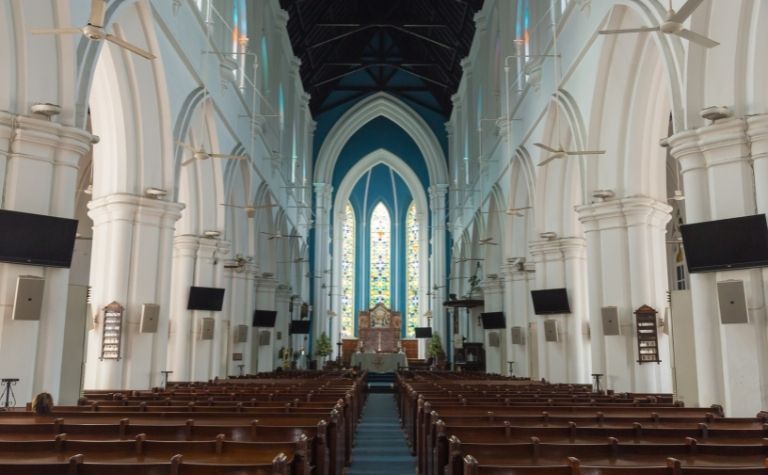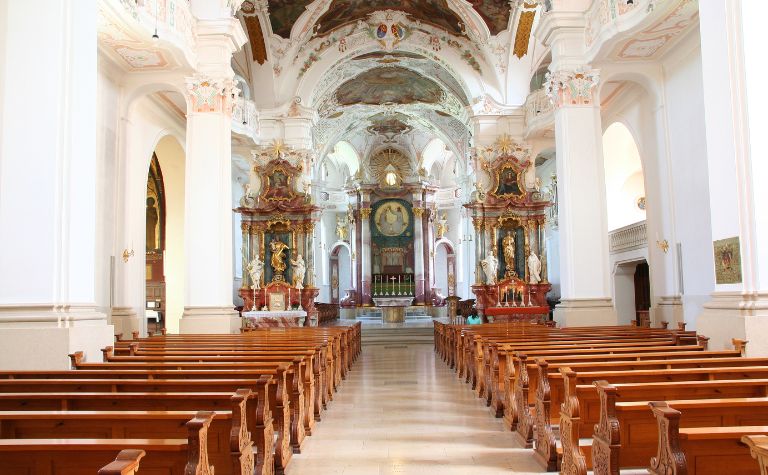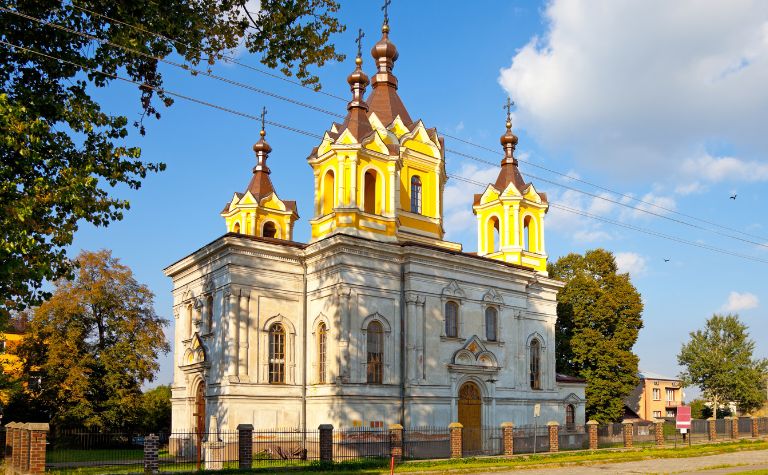Roman Catholicism, Protestant Christianity, and the Eastern Orthodox Church are the three historical branches of the Christian religion. Each tradition traces its doctrines and practices to the New Testament. There are many areas of agreement among Catholic, Protestant, and Orthodox churches, yet there are also important differences.
The Catholic Church and Orthodox Church locate their authority in the Bible and tradition, though they disagree on which tradition. Though it values tradition, Protestantism locates its authority in the Bible alone. As a result, they agree on some doctrines (e.g., Trinity) yet disagree on others (e.g., the pope).
Which branch is the largest, and which one is the smallest? Why did the Eastern Orthodox Church split from Catholicism? Why did Protestants? How do the branches’ beliefs about the Bible, the Holy Spirit, the Lord’s Supper, and the use of icons compare? Keep reading to learn the answers to these questions and others.
Also, see Presbyterian vs. Baptist: What’s the Difference? to learn more.

Roman Catholicism, Protestant Christianity, and Eastern Orthodoxy Compared
The historical relationship between Catholic, Protestant, and Orthodox people is founded upon disagreement, distrust, and division. In recent years, groups from each tradition have engaged in friendly dialog and sometimes pursued reconciliation for past grievances.
For example, while Vatican I (1869-1870) was seen as a setback to Catholic relations with Protestant and Orthodox churches, Vatican II (1962-1965) was seen as a step toward a better relationship with both.
In part, cordial dialog between the traditions has been based on recognizing areas of agreement on theological and social issues.
| Catholic | Protestant | Orthodox | |
|---|---|---|---|
| Name | The word “Roman” is derived from the city of Rome, Italy. The word “catholic,” in general use, means “universal.” In the phrase “Roman Catholic,” Catholic refers to the worldwide collection of churches in the Catholic tradition. | The word “Protestant” comes from the Latin word protestari, meaning “to bear witness,” and the English word “protest.” The first reformers, like Martin Luther (1483-1546) of Germany, were “protesting” certain doctrines and practices of the Catholic church. | “Eastern” refers to the geographical area of the Orthodox tradition, whose capital was Constantinople. The “Western” church refers to Roman Catholicism, whose capital was Rome. “Orthodox” comes from a Greek word meaning “correct belief.” |
| Founding | Catholicism teaches that its origins are the origins of the church itself in the first century. The office of the pope, as Vicar of Christ, started with the Apostle Peter. | Protestantism traces its theological roots to the New Testament church. The movement that started in 16th-century Europe was an effort to re-establish that foundation. Germany, under the reforms of Martin Luther, is considered the Reformation’s origin. | In 1054 A.D., a split occurred between the Eastern and Western churches in the Mediterranean region. The division is commonly referred to as the East-West schism. The West was Catholic. The East was Orthodox. |
| Early contributors | In addition to Peter, Paul, and the other Apostles, the first bishops of Rome, the early church fathers, including Ignatius of Antioch (died 108 AD, according to Eusebius) and Irenaeus (130-202 AD), are considered early influencers. | Protestantism teaches that it’s built upon the Apostles and certain early church fathers, like Augustine (354-430). Martin Luther, John Calvin of France (1509-1564), and Ulrich Zwingli of Switzerland (1484-1531) are considered the forefathers of the Reformation. | Early influencers in the Orthodox Church include Patriarch Michael I Cerularius of Constantinople (1000-1059) and the so-called Three Pillars of Orthodoxy: Photios I of Constantinople (810-893), Mark of Ephesus (1392-1444), and Gregory Palamas (1296-1359). |
Also, see Catholic Lord’s Prayer vs. Protestant Lord’s Prayer Comparison to learn more.
| Catholic | Protestant | Orthodox | |
|---|---|---|---|
| Membership | The Catholic Church reports a global membership of over 1.3 billion people. Catholicism, though rooted in the Western world, is ethnically diverse today. | Protestantism has an estimated 900 million to one billion members. Since Protestantism is a collection of autonomous denominations and churches, its membership total is a combination of denominational censuses. | The Orthodox Church reports a global membership of 220 million worldwide. Though the church originally consisted mostly of Greek people, today, it’s largely made up of people with Slavic origins (e.g., Russian, Ukrainian, Polish, etc.). |
| Ecumenical Councils | The Roman Catholic Church recognizes and accepts all 21 ecumenical councils. | Protestant churches agree with the doctrines articulated in the first seven councils of the 4th to 8th centuries. | The Orthodox Church accepts the first seven ecumenical councils. |
| Authority | Roman Catholicism locates its authority in Scripture and the historical teachings of its tradition. Catholicism teaches that the pope is the Vicar of Christ on Earth, a belief that Protestants strongly reject. | Protestants believe that Scripture alone is authoritative for establishing doctrine and proper Christian practice. Teachers, pastors, ministers, theologians, and other leaders and influencers in church history are only as good as the degree to which they reflect the teachings of Scripture. | Similar to Catholicism, the Orthodox Church believes that Scripture and tradition are authoritative for establishing doctrine and practice. |
| Social worldview today | The Catholic Church is generally considered conservative in the context of the socio-political landscape of the 21st-century Western world. | Many mainline Protestant denominations, especially in North America, have embraced liberal ideology in recent years. Within Protestantism, fundamentalism and evangelicalism are conservative bastions. | The Orthodox Church is conservative theologically and socially, according to conventionally accepted, modern-day definitions of the term. |
Also, see Roman Catholic vs. Eastern Orthodox: What’s the Difference? to learn more.

Catholic, Protestant, and Orthodox Beliefs: Similarities and Differences
| Catholic | Protestant | Orthodox | |
|---|---|---|---|
| View of the Bible | The Catholic Church teaches that the Bible is the inspired Word of God. It, along with tradition, is authoritative for establishing sound doctrine and practice. | One of the hallmarks of the Protestant tradition is the authority of Scripture over and above tradition. Protestants historically believe in the inspiration and authority of Scripture. Some conservatives describe the Bible as inerrant and infallible. | The Bible, along with sacred tradition, is the source of doctrine and practice in The Orthodox Church. |
| View of the Apocrypha or Deutero- canon | The Catholic Bible includes the deutero-canonical literature or Apocrypha in their Old Testament (e.g., Tobit, Judith, Wisdom of Solomon). | Protestants don’t include the Apocrypha or deutero-canon in their Bibles. Some Protestants read the books out of historical interest. | The Orthodox Church includes the Apocrypha or deutero- canon in their Bibles. It also includes books like 1 Esdras and Psalm 151 from the Septuagint. |
| View of God | The Catholic Church teaches that God is Triune. The Father, Son, who is Jesus Christ, and the Holy Spirit, are each fully God. | Protestants believe in the Trinity, i.e., there is one God who exists in three persons. The Father, Son, and Holy Spirit are each fully divine. | Eastern Orthodoxy believes that God is Triune, but unlike Catholicism and Protestantism, it does not believe that the Holy Spirit proceeds from the Father and Son but only from the Father. |
| View of Christ | The Catholic Church believes Jesus of Nazareth is the incarnated second person of the Trinity. He was virgin-born, sinless in life, and died for the sins of humanity. Jesus physically rose from the dead and ascended into heaven. | Jesus is the second person of the Trinity. He is God in human flesh. He is 100% God and 100% man. Jesus was born of a virgin, lived a sinless life, died as an atonement for sin, was physically resurrected on the third day, and ascended into heaven. | The second person of the Trinity became a man in the person of Jesus of Nazareth. Jesus was virgin-born and lived a sinless life. The Orthodox Church affirms the historical, physical resurrection of Christ from the dead. |
| View of Salvation | Catholicism teaches that God imparts grace to people through the sacraments. Justification includes forgiveness, regeneration, and sanctification. Sanctification refers to a person’s progressive growth in holiness and Christ-likeness. | Salvation is by grace through faith in Christ alone. Neither baptism, communion, nor church membership are necessary for salvation. Justification is a declaration, based on the work of Christ on the cross, that sinners are made righteous. Righteousness is transferred to people and isn’t the result of ongoing sanctification. | The Orthodox view of salvation is based on 2 Peter 1:4 and is called “deification,” which refers to a process of becoming more like God. Deification does not mean that believers will become exactly like God in his essence. |

Also, see Christianity and Mormonism Comparison to learn more.
| Catholic | Protestant | Orthodox | |
|---|---|---|---|
| View of the Holy Spirit | The Holy Spirit is the third person of the Trinity. He is fully divine. The Spirit indwells Christians and gives them spiritual gifts for the edification of the Church. Catholicism believes the Holy Spirit proceeds from the Father and the Son. | Protestantism generally believes in the same fundamental truths about the person and work of the Holy Spirit. Within Protestantism, pentecostalism is a growing and influential movement. Pentecostalism believes that speaking in tongues is the initial evidence of being baptized in the Holy Spirit. | The Holy Spirit is the third person of the Trinity and is fully God, according to Orthodox teachings. The Spirit is distinct from the Father and the Son. “Christ sends the Holy Spirit who proceeds from the Father,” according to Orthodox teaching. |
| Human Leader | The Pope is the Vicar of Christ and the head of the Church on Earth, an office that church teaching traces to the Apostle Peter. | Protestantism doesn’t have a single leader and rejects the authority of the pope. Many denominations have a president or similar leader, but they are often governed by cabinets or boards. | The Ecumenical Patriarch of Constantinople on the head of the Orthodox Church. The Orthodox Church honors the Catholic pope but doesn’t recognize the office as having ultimate authority. |
| Rites | Called “Mass,” meaning “to send” in Latin, is centered on the Eucharist, which the Catholic Church teaches is the “source and summit of the Christian life.” | Protestants don’t use the term “rites.” Some Protestant churches are liturgical, but others aren’t. Because of the Bible’s importance, sermons are a key element to worship services. | Called “The Divine Liturgy,” the length of the service, the use of incense, as well as images and symbols, characterize the liturgy in Orthodox churches. |
| View of the Ordinances or Sacraments | There are seven sacraments in Catholicism: (1) adult and infant baptism, (2) confirmation, (3) the Eucharist, (4) penance, (5) anointing, (6) ordination, and (7) marriage. These practices are channels of God’s grace, according to Catholic theology. | Protestants believe there are only two ordinances: the Lord’s Supper and water baptism. There are only two because those are the only ones Christ taught. The others are creations of the church, according to Protestant teaching. In Protestantism, faith is the channel of God’s grace. | The Orthodox Church prefers the term “sacred mysteries.” Orthodox teaching conventionally lists seven: communion, baptism, Chrismation, confession, unction, matrimony, and ordination. |
Also, see Roman Catholic vs. Protestant: What’s the Difference? to learn more.
| Catholic | Protestant | Orthodox | |
|---|---|---|---|
| View of the Lord’s Supper | The “Eucharist,” meaning “to thank,” is a memorial in which the bread and cup become the body and blood of Christ. The change in the nature of the elements is called transubstantiation. | Views about the Lord’s Supper vary widely in Protestantism, though no denomination affirms transubstantiation. Baptists, Presbyterians, and Lutherans all have different theological beliefs about the nature of the bread and cup at the Lord’s Supper. | The Orthodox Church teaches that the bread and cup literally turn into the body and blood of Christ, but it does not attempt to explain exactly how it occurs. |
| View of the Baptism | Sometimes referred to as “paedobaptism” (paedo = “child”), according to Catholic teaching, children of Christian parents are baptized to cleanse them of original sin and regenerate them. | Generally, Protestants believe baptism identifies a person with the death and resurrection of Christ (Rom. 6:3-5). It also signifies their inclusion into the church community (Acts 2:38-47). Protestants don’t agree about who (children or adults) should be baptized and how (sprinkling or immersion). | Bishops and priests administer baptism, in which subjects are immersed three times, once for each member of the Trinity. Eastern Orthodoxy teaches that baptism regenerates a person and makes them a member of the true church. |
| Icons | The Roman Catholic Church has icons. People use them in different ways to enhance their devotion. Some historians argue that icons in Catholicism have never had the same importance that they do in the Orthodox Church. | Icons are rare in Protestantism. Some Protestants use pictures of Jesus, but others believe such images are a violation of the second commandment. | The Eastern Orthodox tradition, throughout its history, has strongly defended the use of icons, which they believe enhance people’s devotion to God. |
| View of the End Times | The Catholic Church affirms the Second Coming of Christ. The church’s eschatology is Amillennial. | Protestants believe in the Second Coming of Christ. Protestant traditions may be Amillennial, Premillennial, or Postmillennial. | Eastern Orthodoxy believes in the return of Christ but does not have a fully developed eschatology as many Protestant traditions do. This is due in part to the Orthodox church’s belief that the book of Revelation is a mystery. |

Please see the related articles below.
Also, see Roman Catholic vs. Christian: What’s the Difference? to learn more.
Related Articles
Pentecostalism vs. Charismatic Movement: What's the Difference?
Many people know that the terms "Pentecostal" and "charismatic" are associated with certain beliefs, churches, and people in modern Christianity but aren't sure how they compare. Although the terms...
The Roman Catholic and Presbyterian branches of the Christian faith trace their origins to Jesus of Nazareth and his apostles, as well as their writings that comprise most of the New Testament. There...
